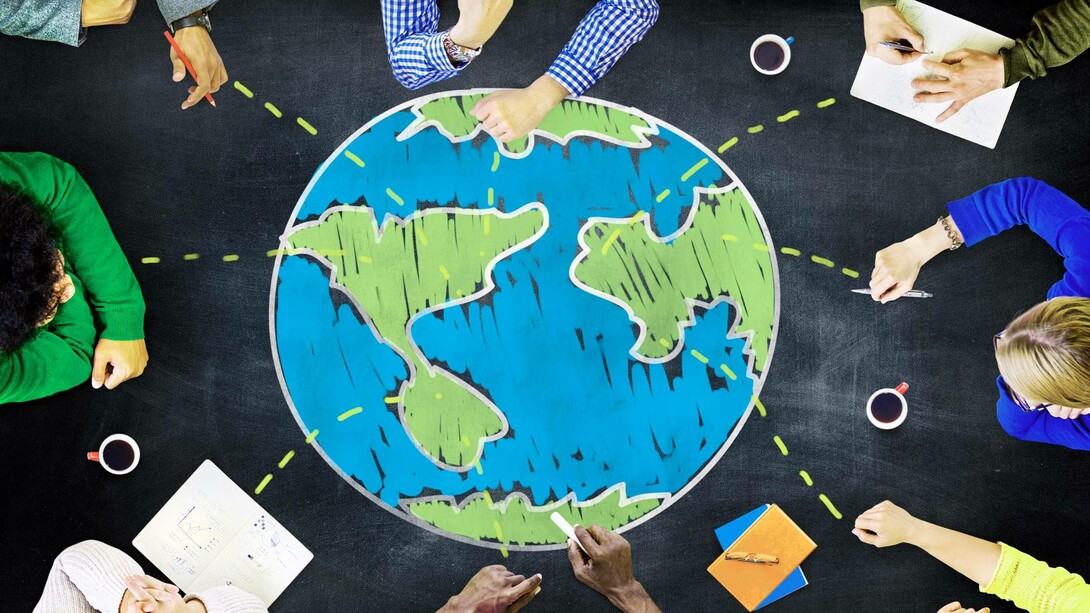Globalization influences culture by blending diverse traditions and practices, creating a more interconnected world. It also leads to cultural homogenization.
Globalization has significantly impacted cultures worldwide. It has fostered a blend of various traditions, leading to a more interconnected and diverse world. People now have easier access to different cultural products, such as music, food, and fashion. This cultural exchange enriches societies and broadens perspectives.
However, globalization also poses the risk of cultural homogenization, where unique local traditions might disappear. Balancing the benefits of cultural exchange with the preservation of unique cultural identities is crucial. Understanding globalization’s impact helps us appreciate diversity while safeguarding cultural heritage for future generations.

Credit: www.linkedin.com
Cultural Exchange
Globalization has made the world more connected. One significant aspect is Cultural Exchange. People share their traditions, art, and music across borders.
Traditions And Practices
Globalization has spread various traditions and practices. For example, people now celebrate different festivals worldwide. Diwali, Christmas, and Chinese New Year are celebrated in many countries. This exchange enriches our lives.
Traditional foods are also shared. Sushi, tacos, and pizza are enjoyed globally. This makes our daily lives more diverse and exciting.
Another example is clothing. Traditional attire like saris, kimonos, and kilts are appreciated worldwide. This promotes cultural understanding and respect.
Art And Music
Globalization has a huge impact on art and music. Artists and musicians now reach a global audience. For instance, K-pop and Bollywood music are popular worldwide. This creates a melting pot of creativity.
Art styles also mix. Western artists adopt techniques from Eastern art, and vice versa. This fusion leads to innovative and unique creations.
Music festivals now feature international artists. This allows people to experience different cultures through music. It promotes unity and mutual appreciation.
| Aspect | Examples | Impact |
|---|---|---|
| Traditions | Diwali, Christmas | Global Celebrations |
| Food | Sushi, Tacos | Cultural Diversity |
| Clothing | Sari, Kimono | Cultural Respect |
| Music | K-pop, Bollywood | Global Audience |
| Art | Eastern Techniques | Innovative Creations |
Globalization has made cultural exchange easier. This exchange helps us learn and grow. It makes the world a richer place.

Credit: www.researchgate.net
Language Evolution
Globalization changes how people speak. It blends languages and creates new ones. This process is called language evolution. It impacts culture in many ways.
Emergence Of Hybrid Languages
Hybrid languages mix elements from different languages. They form when people from different cultures interact. These languages are easy to learn. They help people communicate better.
Examples of hybrid languages include:
- Spanglish: A mix of Spanish and English.
- Hinglish: A combination of Hindi and English.
- Taglish: A blend of Tagalog and English.
Hybrid languages often become popular in urban areas. They reflect the diverse cultures in these regions.
Preservation Of Native Languages
Many native languages face extinction. Globalization promotes dominant languages like English. This puts smaller languages at risk. Efforts to preserve native languages are crucial.
Strategies to preserve native languages:
- Teach them in schools.
- Use them in media and literature.
- Encourage young people to speak them.
Some communities create language preservation programs. They document and share their native languages. This helps keep their culture alive.
Food And Cuisine
Globalization has transformed our food and cuisine. Cultures now share their unique dishes worldwide. This exchange has enriched our culinary experiences. People now enjoy diverse flavors and cooking styles.
Fusion Dishes
Fusion dishes blend ingredients and techniques from different cultures. These dishes create unique flavors and textures. Examples include sushi burritos and Korean tacos. Fusion dishes are popular in many countries.
Restaurants often experiment with fusion cuisine. They combine traditional recipes with new ingredients. This results in exciting and delicious meals. Fusion dishes attract food lovers from all backgrounds.
Here are some popular fusion dishes:
- California roll (Japanese and American)
- Butter chicken pizza (Indian and Italian)
- Ramen burger (Japanese and American)
- Kimchi quesadilla (Korean and Mexican)
Global Food Chains
Global food chains have spread across the world. These chains offer familiar meals in different countries. Fast food giants like McDonald’s and KFC are everywhere. Their menus adapt to local tastes and preferences.
Global food chains help people experience new cuisines. They introduce customers to foreign dishes. This creates a global food culture. Local businesses often compete with these chains. They may adopt new practices to attract customers.
Below is a table showing some global food chains and their popular items:
| Chain | Popular Item | Country of Origin |
|---|---|---|
| McDonald’s | Big Mac | USA |
| KFC | Fried Chicken | USA |
| Sushi King | Sushi Rolls | Japan |
| Nando’s | Peri-Peri Chicken | South Africa |
Fashion Trends
Globalization has significantly influenced fashion trends worldwide. It has brought various cultures closer. This impact is visible in how people dress.
Cross-cultural Influences
Fashion today showcases a blend of diverse cultural elements. People adopt styles from different parts of the world. This creates unique and eclectic outfits.
For example, the kimono from Japan is now a popular fashion statement globally. Similarly, the sari from India is admired and worn by many worldwide.
Western fashion also influences many cultures. Jeans and t-shirts are now wardrobe staples everywhere. This mix enriches the fashion industry, making it more inclusive.
Global Fashion Icons
Global fashion icons play a crucial role in spreading trends. Celebrities and influencers often set the stage for what’s fashionable.
Consider Rihanna. Her unique style influences millions globally. She blends elements from different cultures, making her a true global icon.
Another example is David Beckham. His style evolution has had a significant impact on men’s fashion worldwide.
These icons help in promoting a global fashion culture. Their influence ensures that fashion trends transcend borders.
Media And Entertainment
The influence of globalization on culture is vast. One of the most significant areas affected is Media and Entertainment. This section explores how international films, TV shows, and global music phenomena shape cultures worldwide.
International Films And Tv Shows
International films and TV shows have a massive impact on culture. They introduce audiences to new perspectives and stories. Hollywood movies reach audiences in every corner of the globe. These films often shape perceptions and influence cultural norms.
Additionally, TV shows from countries like South Korea and Spain are gaining global popularity. Platforms like Netflix and Amazon Prime make foreign content accessible. This global reach helps spread cultural elements far and wide.
| Region | Popular TV Show | Impact |
|---|---|---|
| South Korea | Squid Game | Global interest in Korean culture |
| Spain | Money Heist | Increased learning of Spanish language |
Global Music Phenomena
Music is another area where globalization has a significant impact. Songs from different parts of the world now achieve global success. Artists like BTS and Shakira have fans across continents. This global reach helps break cultural barriers and unite people.
Streaming platforms like Spotify and Apple Music play a crucial role. They allow users to discover music from any part of the world. This easy access fosters a global musical culture.
- BTS: Popularizes K-pop globally.
- Shakira: Introduces Latin music to a broader audience.
- Drake: Merges different musical styles, creating a unique sound.
These artists influence fashion, language, and even social movements. Global music phenomena highlight the unifying power of music.
Social Norms
Globalization has deeply impacted social norms around the world. These norms dictate how people behave and interact in society. With the global exchange of ideas and cultures, these norms are evolving rapidly. This section explores the changes in family structures and shifts in gender roles due to globalization.
Changing Family Structures
Family structures are changing globally. Nuclear families are replacing extended families in many cultures. This change is driven by urbanization and economic factors.
People are moving to cities for better jobs. This causes families to become smaller. Single-parent families are also becoming more common. This is due to increased divorce rates and more children born out of wedlock.
Here is a comparison of traditional and modern family structures:
| Traditional Family | Modern Family |
|---|---|
| Extended family living together | Nuclear family living separately |
| Multiple generations under one roof | Single or two-parent households |
| Strong community ties | Individualistic lifestyle |
Shifts In Gender Roles
Gender roles are also changing due to globalization. More women are working outside the home. This has led to greater gender equality. In many cultures, men are taking on more household duties.
Here are some key changes in gender roles:
- Women are pursuing higher education and careers.
- Men are participating in childcare and housework.
- Both genders are sharing financial responsibilities.
These changes are creating more balanced and equitable societies. Traditional roles are being redefined, allowing for greater personal freedom and choice.
Technology And Communication
Technology and communication have changed our world. They have connected people across the globe. This connection has impacted cultures in many ways.
Social Media Impact
Social media has a huge impact on culture. It allows people to share ideas quickly. People can learn about other cultures instantly.
Social media platforms like Facebook, Instagram, and Twitter have made this possible. They let people see and experience different lifestyles. This can lead to cultural understanding and appreciation.
But social media also has downsides. It can spread misinformation. It can create cultural stereotypes. Understanding these impacts is important.
Virtual Communities
Virtual communities bring people with shared interests together. These communities exist online, breaking geographical barriers.
People can join groups about music, art, or hobbies. They can connect with others who share their passions. This fosters a sense of belonging and cultural exchange.
Virtual communities can also support minority cultures. They provide a space for cultural preservation. Members can share traditions and languages, keeping them alive.
Here’s a simple table showing the benefits and downsides of virtual communities:
| Benefits | Downsides |
|---|---|
| Connect with like-minded people | Can create echo chambers |
| Preserve minority cultures | May exclude outside viewpoints |
| Share and learn new ideas | Risk of misinformation |
Economic Influence
Globalization has a profound impact on culture, particularly through economic influence. This influence alters how cultures interact and evolve. As economies become interconnected, cultural elements are traded, sold, and consumed globally. Let’s dive into how this economic influence manifests itself.
Consumer Culture
Globalization shapes a global consumer culture. Products from one country are now available in another. This access changes buying habits and preferences.
People adopt new styles, foods, and gadgets from around the world. This widespread availability of foreign products leads to a mix of cultural elements. It creates a blend of local and global tastes.
For example, fast food from the United States is popular worldwide. Local cuisines adapt to include these new options. This fusion is a direct result of economic influence.
Cultural Commodification
Through globalization, cultures can become commodified. This means cultural elements are packaged and sold. Traditional crafts, music, and festivals can turn into products for tourists and global markets.
Commodification can lead to the loss of cultural authenticity. Original meanings and contexts may get lost. Yet, it also preserves and spreads cultural knowledge. By selling cultural items, people learn about different traditions.
Here is a table summarizing the effects of cultural commodification:
| Positive Effects | Negative Effects |
|---|---|
| Preservation of culture | Loss of authenticity |
| Global awareness | Exploitation of culture |
| Economic benefits | Over-commercialization |
Understanding these effects helps navigate the balance between cultural preservation and economic gain.

Credit: www.researchgate.net
Conclusion
Globalization shapes our cultural landscape, blending traditions and modern influences. This fusion enriches societies but also challenges cultural identities. Understanding its impact helps preserve heritage while embracing global diversity. Stay informed and appreciate the evolving cultural dynamics around us. This balance ensures cultural preservation in an interconnected world.

